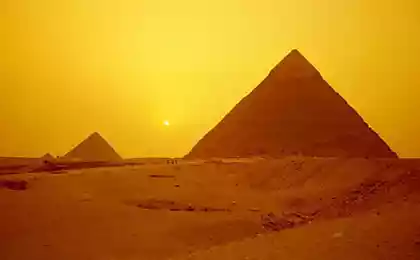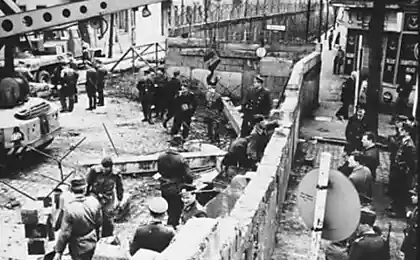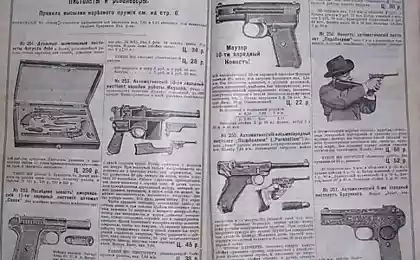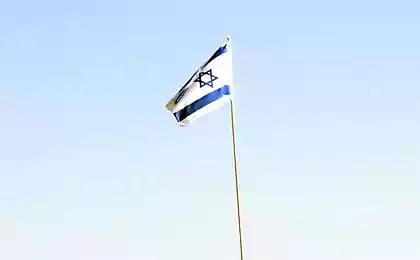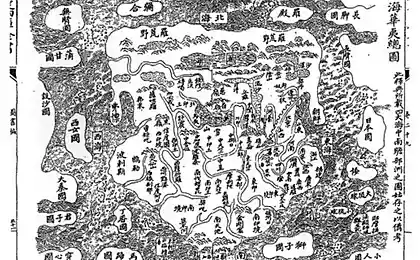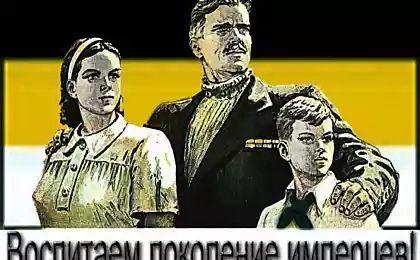2542
The largest empire

Japanese Empire
Japan - the only empire in the modern political map. Now this status rather formal, but still 70 years ago it was a major center of Tokyo imperialism in Asia. Japan - an ally of the Third Reich and Fascist Italy - then tried to establish control over the west coast of the Pacific Ocean, dividing extensive front with the Americans. At this time, was the peak of the territorial scope of the Empire, which controlled almost all maritime space and 7, 4 million sq. M. km of land from Sakhalin to New Guinea.

Population: 97770 000
Area of the state: 7, 4 million km2
Capital: Tokyo
Start ruling: 1868
The Fall of the Empire: 1947

Persian Empire
One of the most ancient empires, the base of which belong to the middle of the I millennium BC. e. Persian tribes conquered the territories of all pre-existing empires of the Middle East: the Egyptians, Assyrians, Babylonians, Medes. During the reign of the Achaemenid dynasty (VI-IV v. BC. E) possession of the Persians took nearly 8 million sq. M. km, which is almost 2 times the size of the empire Julius Gaius Caesar. Majesty ancestors of modern Iranians moved to Alexander the Great, conquered most of the state. After the invasion of the Persian Empire Macedonians several times appeared on the map of the ancient world, until its final defeat of the Arab conquerors in the VII century BC. e.

Population: 50 million. H. (480 BC. E.) / 35 million. H. (330 BC. E.)
Area of the state: - Capital: Persepolis
Start ruling: 530 BC
The Fall of the Empire: 334 BC. e

The Portuguese Empire
Since the XVI century, the Portuguese were looking for ways to break the isolation of the Spanish in the Iberian Peninsula. In 1497 they opened the sea route to India, which gave rise to the widening of the Portuguese colonial empire. Three years earlier between the "bitter neighbors" was signed the Treaty of Tordesillas, actually divided between the two countries known at the time the world, on unfavorable conditions for the last Portuguese. But that did not stop them to collect more than 10 million sq. M. km of land, most of which was occupied by Brazil. Transfer of Macao to the Chinese in 1999 completed the colonial history of Portugal.

Capital: Coimbra, Lisbon
Start ruling: July 26, 1139 Mr.
The Fall of the Empire: October 5, 1910

Arab Empire
The existence of the empire marked the TOE. "Golden age of Islam" - the period from VII to XIII century BC. e. Based Caliphate immediately after the death of the founder of the Muslim faith of Muhammad in 632, and it became the core of the Medina community founded by prophet. Century Arab conquests expanded the empire to 13 million sq. M. km, covering the territory of all three parts of the Old World. By the middle of the XIII century Caliphate, torn by internal conflicts, so weak that he was easily captured by the Mongols at first, and then the Ottomans - the founders of the other great Scythian Empire.

Population: - The area of the state: - Capital: Medina 630-656 / 656 - 661 Mecca / 661 - 754 Damascus / 754 - 762 Kufa / 762 - 836 Baghdad / 836 - 892 Samarra / 892 - 1258 Baghdad
Start ruling: 632 g
The Fall of the Empire: 1258 g

French Empire
France became the third European country (after Spain and Portugal), which is interested in the Overseas Territories. Starting from 1546 - the founding of New France (now Quebec, Canada) - originates the formation of the Francophonie in the world. After losing the American confrontation Anglo-Saxons, and inspired by the conquests of Napoleon, the French occupied almost the whole of West Africa. In the mid-twentieth century, the area of the empire reached 13, 5 million sq. M. km, it is home to more than 110 million. people. By 1962, most of the French colonies became independent states.

Population: - The area of the state: 13, 5 million sq. M. km
Capital: Paris
Start ruling: 1546 g
The Fall of the Empire: 1940

Chinese Empire
Ancient empires of Asia, the cradle of oriental culture. The first Chinese dynasty ruled more from the II millennium BC. e., but a unified empire was only established in 221 BC. e. During the reign of the Qing - last monarchical dynasty China - Empire occupied a record area of 14, 7 million sq. M. km. This is a 1, 5 times more than the modern Chinese state, mainly due to Mongolia, now independent. In 1911 Xinhai Revolution broke out, put an end to monarchical structure in China, making the Empire to the Republic.

Population: 383.1 million people.
Area of the state: 14, 7 million. Km2
Capital: Mukden (1636-1644), Beijing (1644-1912)
Start ruling: 1616
The Fall of the Empire: 1912

The Spanish Empire
Period of world domination of Spain began with the voyage of Columbus, has opened new horizons for the Catholic missionary and territorial expansion. In the XVI century, almost all the Western Hemisphere was "at the feet" of the Spanish king with his "invincible armada". It was at this time, Spain was called "the land where the sun never sit", because of its ownership of the land covered seventh (about 20 million. Sq. Km) and almost half of the sea routes in all parts of the world. The greatest empire of the Incas and Aztecs fell before the conquistadors, and in their place was formed predominantly Hispanic Latin America.

Population: 60 million.
State Area: 20 000 000 km2
Capital: Toledo (1492-1561) / Madrid (1561-1601) / Valladolid (1601-1606) / Madrid (1606-1898)
Start ruling: April 17, 1492
The Fall of the Empire: 1898
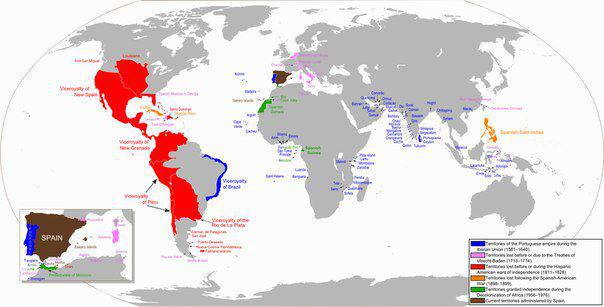
Russian Empire
Large continental monarchy in the history of mankind. Its roots reach the time of the Moscow principality, then the kingdom. In 1721 Peter I proclaimed the Russian imperial status, which owned vast territories from Finland to Chukotka. At the end of the XIX century the state reached its climax Geographic: 24, 5 million sq. M. km, about 130 million people, more than 100 ethnic groups and nationalities. Russian possessions at the time were the lands of Alaska (before its sale to the Americans in 1867), as well as part of California.

Population: 60 million.
Population: 181, 5 million (1916)
State Area: 20 000 000 km2
Capital: Saint-Petersburg, Moscow
Start ruling: October 22, 1721
The Fall of the Empire: 1917

British Empire
Over the 400 years of its formation, it has withstood the competition for world domination with other "colonial Titans": France, Holland, Spain, Portugal. In its heyday London controlled a quarter of the world's land area (more than 34 million. Sq. Km) in all the inhabited continents, as well as the vast expanses of the ocean. Formally, it still exists in the form of the Commonwealth, and countries such as Canada and Australia are the actual subject to the British crown.

Population: 458 million people. (About 24% of the population in the 1922)
State Area: 34,650,407 km2 (1922)
Capital: London
Start ruling: 1497 g
The Fall of the Empire: 1949 (1997) Mr.

Mongol Empire
The greatest empire of all time, whose raison d'être was one - the war. Great Mongolian state was formed in 1206 under the leadership of Genghis Khan that grew over several decades to 38 million sq. M. km from the Baltic Sea to Vietnam, and at the same time killing every tenth inhabitant of the Earth. By the end of the XIII century it Uluses covered a quarter of the land and a third of the world's population, which then numbered almost half a billion people. On the ruins of the empire formed an ethno-political framework of modern Eurasia.

Population: more than 110 million people. (1279)
State Area: 38 000 000 km square. (1279)
Capital: Karakorum Khanbalik
Start ruling: 1206
The Fall of the Empire: 1368 g
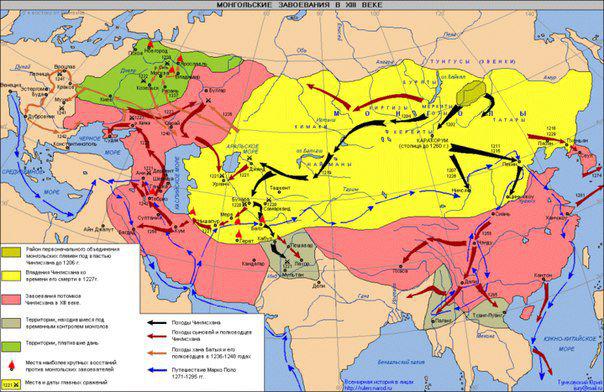
Source: ya-ru.ru
